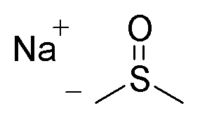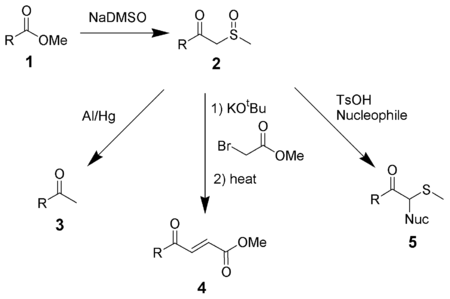- Sodium methylsulfinylmethylide
-
Sodium methylsulfinylmethylide  Sodium methylsulfinylmethylideOther namessodium dimsylate, dimsylsodium, NaDMSYL
Sodium methylsulfinylmethylideOther namessodium dimsylate, dimsylsodium, NaDMSYLIdentifiers Abbreviations NaDMSO CAS number 15590-23-5 ChemSpider 8329518 
Jmol-3D images Image 1 - [Na+].O=S([CH2-])C
Properties Molecular formula C2H5NaOS Molar mass 100.13 Solubility in water Reactive Solubility in DMSO Soluble Related compounds Related compounds Dimethyloxosulfonium methylide  methylsulfinylmethylide (verify) (what is:
methylsulfinylmethylide (verify) (what is:  /
/ ?)
?)
Except where noted otherwise, data are given for materials in their standard state (at 25 °C, 100 kPa)Infobox references Sodium methylsulfinylmethylide (also called NaDMSO or dimsyl sodium) is the conjugate base of dimethyl sulfoxide. It has several uses in organic chemistry as a base and nucleophile.
Since the first publication in 1965 by Corey et al.[1], a large number of publications have described additional uses for this reagent.[2]
Contents
Preparation
Sodium methylsulfinylmethylide is prepared by heating sodium hydride[3] or sodium amide[4] in DMSO.
- CH3SOCH3 + NaH → CH3SOCH2−Na+ + H2
- CH3SOCH3 + NaNH2 → CH3SOCH2−Na+ + NH3
Reactions
As a Base
The pKa of DMSO is 35, which leads NaDMSO to be a powerful Brønsted base. NaDMSO is used in the generation of phosphorus and sulfur ylides.[5] NaDMSO in DMSO is especially convenient in the generation of dimethyloxosulfonium methylide and dimethylsulfonium methylide.[1][6]
Reaction with esters
NaDMSO will condense with esters (1) to form β-ketosulfoxides (2), which have been shown to be very useful synthetic intermediates.[7] Reduction of β-ketosulfoxides with aluminium amalgam gives methyl ketones (3).[8] Reaction with alkyl halides followed by elimination gives α,β-unsaturated ketones (4). Interestingly, β-ketosulfoxides can also be used in the Pummerer rearrangement to introduce nucleophiles alpha to a carbonyl (5).[9]
References
- ^ a b Corey, E. J.; Chaykovsky, M (1965). "Methylsulfinyl Carbanion (CH3-SO-CH2−). Formation and Applications to Organic Synthesis". J. Am. Chem. Soc. 87: 1345. doi:10.1021/ja01084a033.
- ^ Durst, T. (1969). (review)Adv. Org. Chem. 6: 285.
- ^ Iwai, I.; Ide, J. (1988), "2,3-Diphenyl-1,3-Butadiene", Org. Synth., http://www.orgsyn.org/orgsyn/orgsyn/prepContent.asp?prep=cv6p0531; Coll. Vol. 6: 531
- ^ Kaiser, E. M; Beard, R. D; Hauser, C. R (1973). "Preparation and reactions of the mono- and dialkali salts of dimethyl sulfone, dimethyl sulfoxide, and related compounds". J. Organomet. Chem. 59: 53. doi:10.1016/S0022-328X(00)95020-4.
- ^ Romo, D; Myers, A. I (1992). "An asymmetric route to enantiomerically pure 1,2,3-trisubstituted cyclopropanes". J. Org. Chem. 57: 6265. doi:10.1021/jo00049a038.
- ^ Trost, B. M.; Melvin, L. S., Jr. (1975). Sulfur Ylides: Emerging Synthetic Intermediates. New York: Academic Press. ISBN 0127010602.
- ^ Ibarra, C. A; Rodgríguez, R. C; Monreal, M. C. F; Navarro, F. J. G; Tesoreo, J. M (1989). "One-pot synthesis of β-keto sulfones and β-keto sulfoxides from carboxylic acids". J. Org. Chem. 54: 5620. doi:10.1021/jo00284a043.
- ^ Swenton, J. S; Anderson, D. K; Jackson, D. K; Narasimhan, L (1981). "1,4-Dipole-metalated quinone strategy to (±)-4-demethoxydaunomycinone and (±)-daunomycinone. Annelation of benzocyclobutenedione monoketals with lithioquinone bisketals". J. Org. Chem. 46: 4825. doi:10.1021/jo00337a002.
- ^ Isibashi, H; Okada, M; Komatsu, H; Ikeda, M. S (1985). Synthesis: 643.
External links
Categories:- Reagents for organic chemistry
Wikimedia Foundation. 2010.

